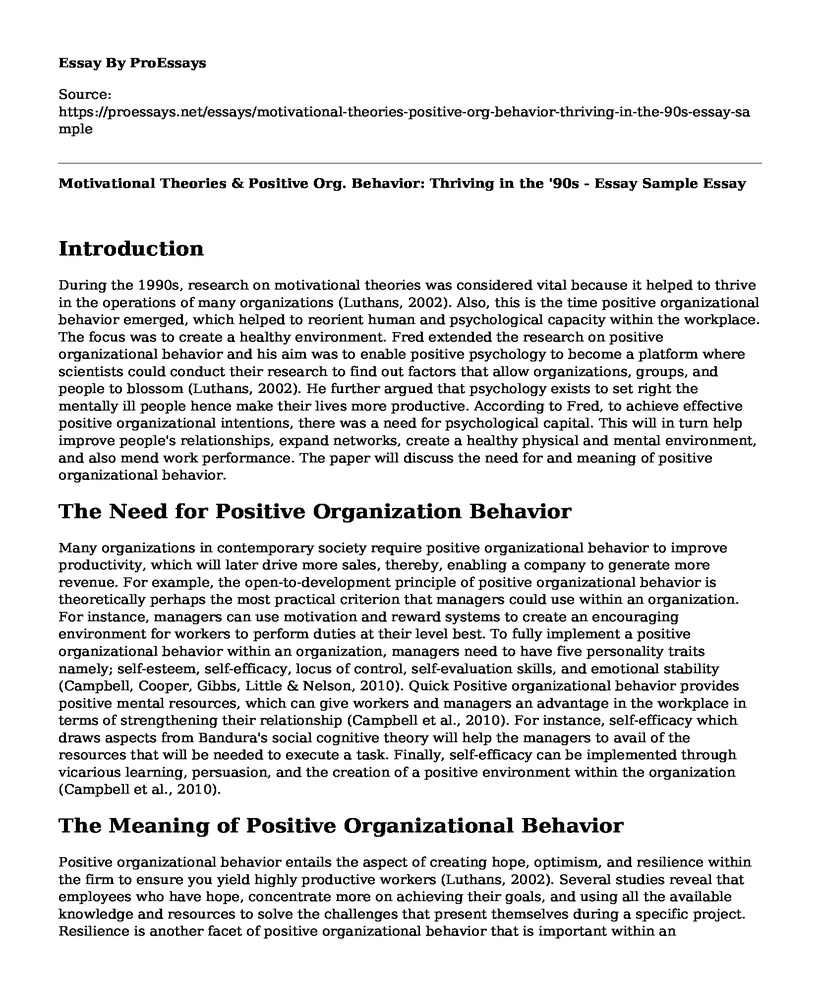Introduction
During the 1990s, research on motivational theories was considered vital because it helped to thrive in the operations of many organizations (Luthans, 2002). Also, this is the time positive organizational behavior emerged, which helped to reorient human and psychological capacity within the workplace. The focus was to create a healthy environment. Fred extended the research on positive organizational behavior and his aim was to enable positive psychology to become a platform where scientists could conduct their research to find out factors that allow organizations, groups, and people to blossom (Luthans, 2002). He further argued that psychology exists to set right the mentally ill people hence make their lives more productive. According to Fred, to achieve effective positive organizational intentions, there was a need for psychological capital. This will in turn help improve people's relationships, expand networks, create a healthy physical and mental environment, and also mend work performance. The paper will discuss the need for and meaning of positive organizational behavior.
The Need for Positive Organization Behavior
Many organizations in contemporary society require positive organizational behavior to improve productivity, which will later drive more sales, thereby, enabling a company to generate more revenue. For example, the open-to-development principle of positive organizational behavior is theoretically perhaps the most practical criterion that managers could use within an organization. For instance, managers can use motivation and reward systems to create an encouraging environment for workers to perform duties at their level best. To fully implement a positive organizational behavior within an organization, managers need to have five personality traits namely; self-esteem, self-efficacy, locus of control, self-evaluation skills, and emotional stability (Campbell, Cooper, Gibbs, Little & Nelson, 2010). Quick Positive organizational behavior provides positive mental resources, which can give workers and managers an advantage in the workplace in terms of strengthening their relationship (Campbell et al., 2010). For instance, self-efficacy which draws aspects from Bandura's social cognitive theory will help the managers to avail of the resources that will be needed to execute a task. Finally, self-efficacy can be implemented through vicarious learning, persuasion, and the creation of a positive environment within the organization (Campbell et al., 2010).
The Meaning of Positive Organizational Behavior
Positive organizational behavior entails the aspect of creating hope, optimism, and resilience within the firm to ensure you yield highly productive workers (Luthans, 2002). Several studies reveal that employees who have hope, concentrate more on achieving their goals, and using all the available knowledge and resources to solve the challenges that present themselves during a specific project. Resilience is another facet of positive organizational behavior that is important within an organization (Campbell et al., 2010). Workers who are resilient have a positive bounce-back reaction to a negative or difficult problem that may be challenging them while executing their tasks on a specific project (Campbell et al., 2010). Finally, managers need to instill hope to their workers, since it will create emotional wellbeing that will provide them with the determination to accomplish the required goals within the organization (Campbell et al., 2010).
Conclusion
Positive organizational behavior has proven effectiveness in the workplace. It reflects the flaws and successes of people in the past and then focuses on some particular events, which make them believe that they can successfully accomplish the same activities in the future. Through positive psychology, people develop some hope, which links their scores to goal-related expectations. Individuals especially the mentally ill learn that it is important to adopt resiliency to create health teamwork and this translates to an excellent business process. Positive organizational behavior, therefore, promotes creativity, augments energy levels, improves social interactions and amplifies high performance within the workplace.
References
Campbell Quick, J., Cooper, C. L., Gibbs, P. C., Little, L. M., & Nelson, D. L. (2010). Positive organizational behavior at work. Retrieved from file:///C:/Users/User/Downloads/IRIOP10%20(1).pdf
Luthans, F. (2002). The need for and meaning of positive organizational behavior. Journal of Organizational Behavior: The International Journal of Industrial, Occupational and Organizational Psychology and Behavior, 23(6), 695-706. https://onlinelibrary.wiley.com/doi/pdf/10.1002/job.165
Cite this page
Motivational Theories & Positive Org. Behavior: Thriving in the '90s - Essay Sample. (2023, Apr 19). Retrieved from https://proessays.net/essays/motivational-theories-positive-org-behavior-thriving-in-the-90s-essay-sample
If you are the original author of this essay and no longer wish to have it published on the ProEssays website, please click below to request its removal:
- Workers in the Cane Essay
- Communication in Organizations Paper Example
- Requirements for Addictions Professional Paper Example
- The Graduate Capabilities Sought by Employers Paper Example
- Paper Example on Expanding Business: Walt Disney Reaches Its Defined Vision
- Paper Example on IAWP: Strengthening Women in Policing since 1915
- Kia Official Big Game Commercial - Report Sample







